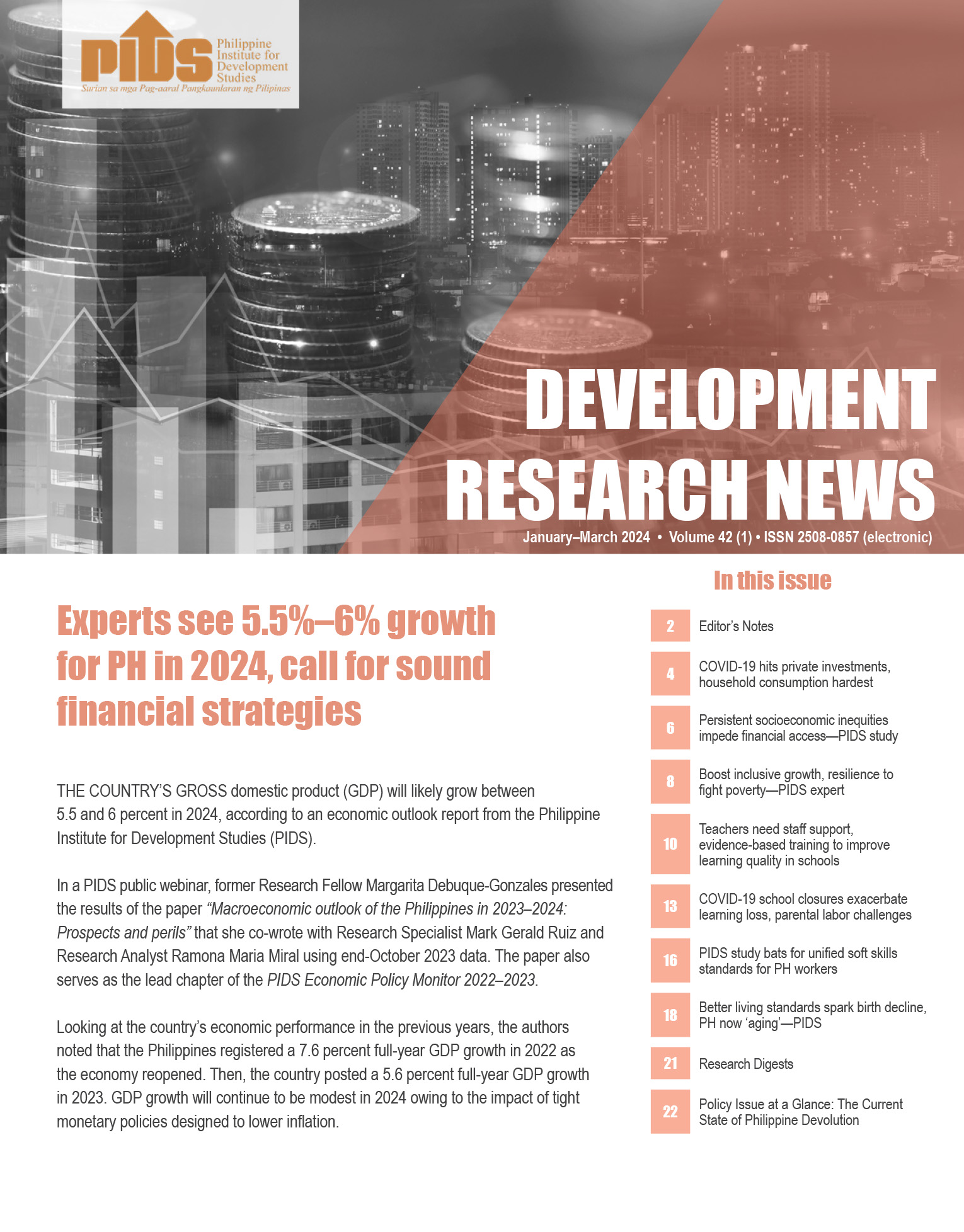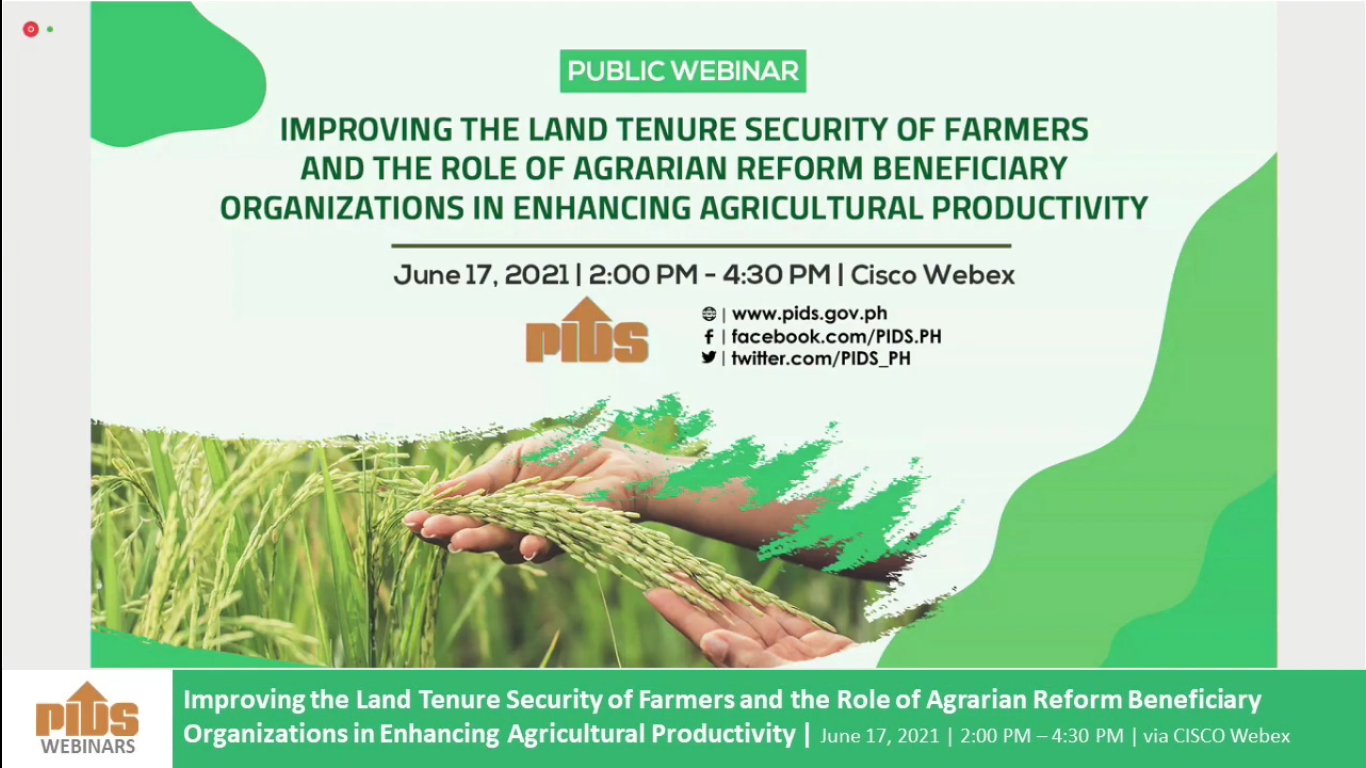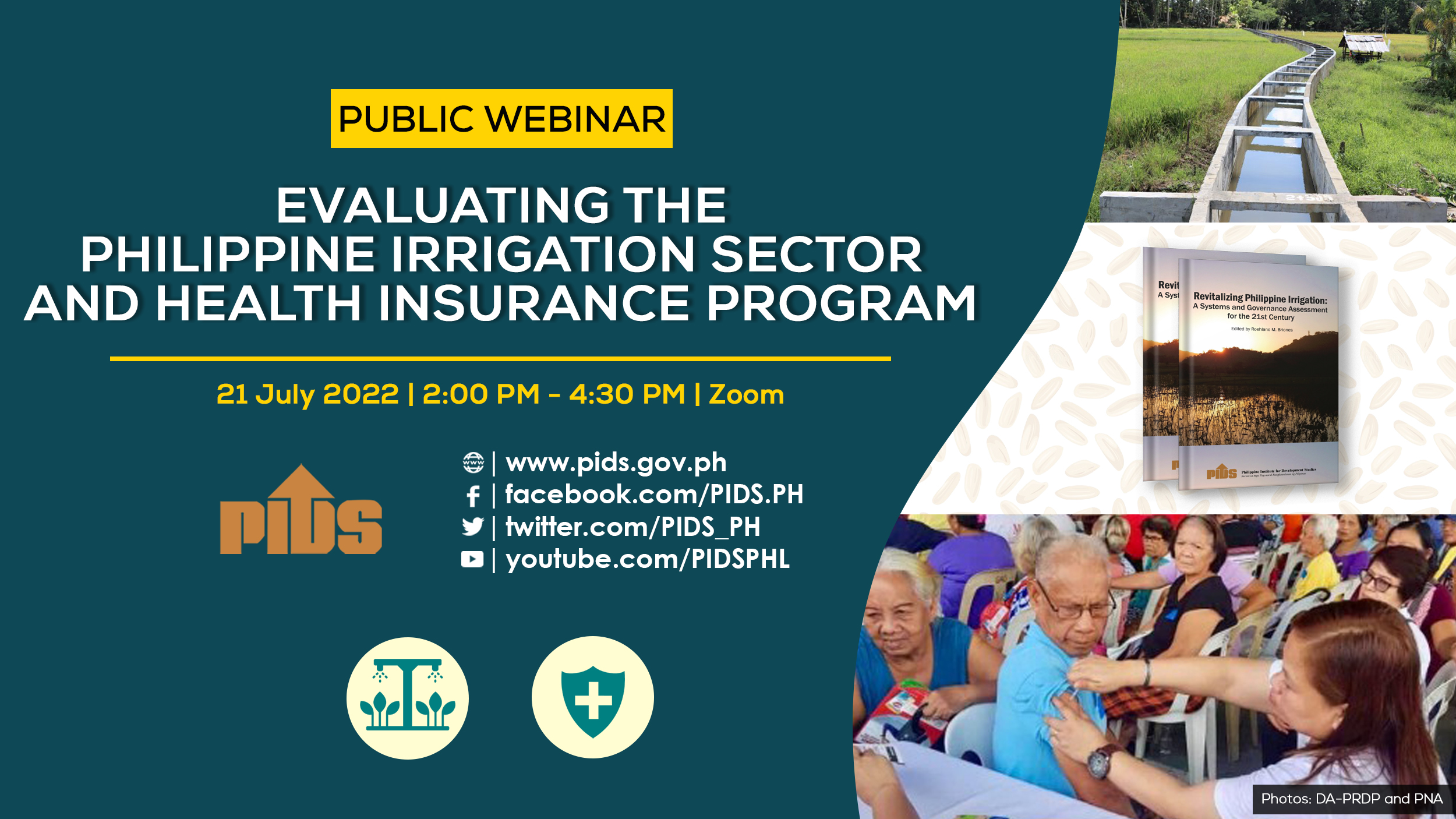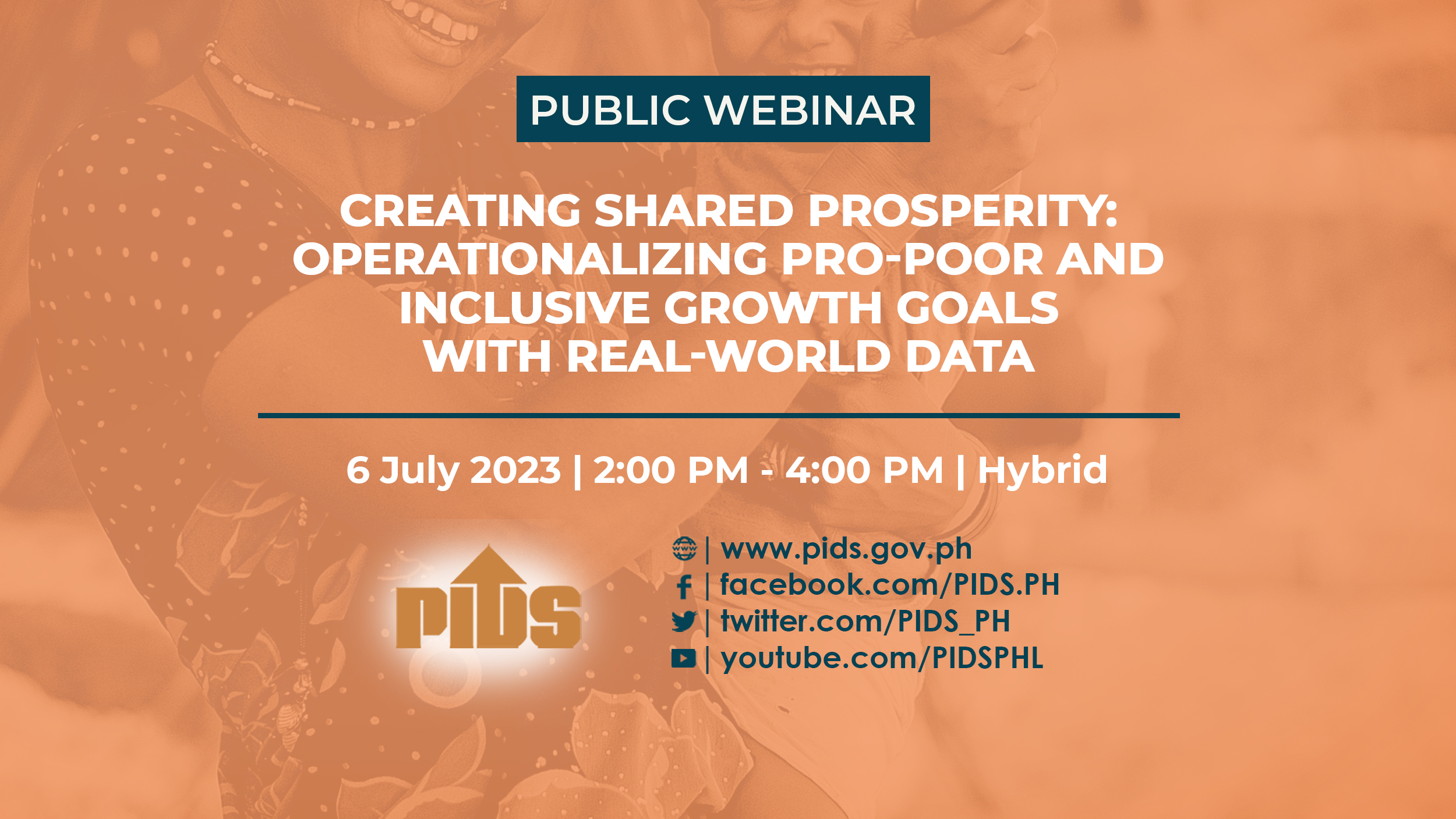In a forum held recently at the House of Representatives in Quezon City, PIDS Senior Research Fellow Celia Reyes noted that around half of the households who are engaged in agriculture can be considered as “sometimes poor”. According to Reyes, these are farmers who usually become poor when they are unable to recover from losses in their farm production after typhoons, flooding, and other calamities. She noted that providing safety nets such as crop insurance can protect these vulnerable households from sliding into poverty.
“Crop insurance helps farmers manage risks by providing them with funds to cover production costs for the next season and finance household expenditures after a shock such as typhoon, flood, and drought,” Reyes stated.
Reyes’ presentation at the House of Representatives was based on a PIDS study that aims to evaluate the design and implementation of the government’s crop insurance program vis-à-vis its objectives as well as its sustainability and impact on farmers. The forum is part of the Legislative Forum Series organized by PIDS and the Congressional Planning and Budget Research Department of the House of Representatives.
The PIDS study, which was conducted in collaboration with major universities around the country, concluded that the Agricultural Insurance Program has a positive impact on farm households’ income and welfare. However, it also noted that the program, which is being implemented by the Philippine Crop Insurance Corporation (PCIC), leaves a lot to be desired.
“Improvements in the design and implementation of the crop insurance program of the PCIC, particularly with regard to the penetration rate and insurance cover, can further increase its benefits to farmers,” Reyes emphasized.
The crop insurance offered by the PCIC is considered as a “production cost insurance” as it typically insures the cost of production inputs of farmers, with prescribed cover ceilings. One of its programs is the free insurance to farmers and fisherfolk that are listed in the Registry System for Basic Sectors in Agriculture (RSBSA). RSBSA is a database of farmers, farm laborers, and fisherfolk in the 75 poorest provinces in the Philippines which the Philippine Statistics Authority maintains.
For the past three years, PCIC’s annual budget has been an average of PHP 1 billion. This amount was increased to P2.5 billion in the proposed 2017 national budget. Under the program, farmers with farm sizes of three hectares and below are the priority beneficiaries. Despite the increase in funding, Reyes noted that the amount is still not enough to cover all eligible beneficiaries under the existing RSBSA program.
In addition, the PIDS study pointed out that the actual insurance cover that PCIC pays is below the average production cost particularly for rice and corn. For example, PCIC’s average amount of cover per hectare for rice in 2015 was around PHP 21, 000 under the RSBSA program while average production cost per hectare is around PHP 42,000. According to Reyes, the low insurance cover is a trade-off of targeting more farmer beneficiaries for the free insurance program. Thus, the PIDS study suggested that given the limited funds, the free insurance premium subsidies should be directed to the poorest farmers.
“Since PCIC will continue using the RSBSA as a targeting tool for giving free insurance premium, there is a need to validate and reconcile the list of farmers and fisherfolk in the RSBSA with the list of agrarian reform beneficiaries (ARBs),” Reyes explained.
Another way for the PCIC to increase coverage rate of insured farmers, particularly for those not listed in the RSBA, is through partnerships with local government units (LGUs) such as in the case of Isabela, Cebu, Negros Oriental, and Davao del Norte. Reyes and her co-authors suggested LGU-PCIC partnerships in the form of full premium subsidy by the LGU or the provision of loans to farmers as the LGU’s counterpart in the insurance premium.
Lastly, the PIDS study highlighted the low level of awareness of target beneficiary farmers about the programs of the PCIC.
“Some farmer groups and LGUs are not aware of the different types of PCIC programs. There are also farmers who are not aware that they are insured under the RSBSA and that they are the priority beneficiaries of the program,” Reyes stated. (PIDS)
“Crop insurance helps farmers manage risks by providing them with funds to cover production costs for the next season and finance household expenditures after a shock such as typhoon, flood, and drought,” Reyes stated.
Reyes’ presentation at the House of Representatives was based on a PIDS study that aims to evaluate the design and implementation of the government’s crop insurance program vis-à-vis its objectives as well as its sustainability and impact on farmers. The forum is part of the Legislative Forum Series organized by PIDS and the Congressional Planning and Budget Research Department of the House of Representatives.
The PIDS study, which was conducted in collaboration with major universities around the country, concluded that the Agricultural Insurance Program has a positive impact on farm households’ income and welfare. However, it also noted that the program, which is being implemented by the Philippine Crop Insurance Corporation (PCIC), leaves a lot to be desired.
“Improvements in the design and implementation of the crop insurance program of the PCIC, particularly with regard to the penetration rate and insurance cover, can further increase its benefits to farmers,” Reyes emphasized.
The crop insurance offered by the PCIC is considered as a “production cost insurance” as it typically insures the cost of production inputs of farmers, with prescribed cover ceilings. One of its programs is the free insurance to farmers and fisherfolk that are listed in the Registry System for Basic Sectors in Agriculture (RSBSA). RSBSA is a database of farmers, farm laborers, and fisherfolk in the 75 poorest provinces in the Philippines which the Philippine Statistics Authority maintains.
For the past three years, PCIC’s annual budget has been an average of PHP 1 billion. This amount was increased to P2.5 billion in the proposed 2017 national budget. Under the program, farmers with farm sizes of three hectares and below are the priority beneficiaries. Despite the increase in funding, Reyes noted that the amount is still not enough to cover all eligible beneficiaries under the existing RSBSA program.
In addition, the PIDS study pointed out that the actual insurance cover that PCIC pays is below the average production cost particularly for rice and corn. For example, PCIC’s average amount of cover per hectare for rice in 2015 was around PHP 21, 000 under the RSBSA program while average production cost per hectare is around PHP 42,000. According to Reyes, the low insurance cover is a trade-off of targeting more farmer beneficiaries for the free insurance program. Thus, the PIDS study suggested that given the limited funds, the free insurance premium subsidies should be directed to the poorest farmers.
“Since PCIC will continue using the RSBSA as a targeting tool for giving free insurance premium, there is a need to validate and reconcile the list of farmers and fisherfolk in the RSBSA with the list of agrarian reform beneficiaries (ARBs),” Reyes explained.
Another way for the PCIC to increase coverage rate of insured farmers, particularly for those not listed in the RSBA, is through partnerships with local government units (LGUs) such as in the case of Isabela, Cebu, Negros Oriental, and Davao del Norte. Reyes and her co-authors suggested LGU-PCIC partnerships in the form of full premium subsidy by the LGU or the provision of loans to farmers as the LGU’s counterpart in the insurance premium.
Lastly, the PIDS study highlighted the low level of awareness of target beneficiary farmers about the programs of the PCIC.
“Some farmer groups and LGUs are not aware of the different types of PCIC programs. There are also farmers who are not aware that they are insured under the RSBSA and that they are the priority beneficiaries of the program,” Reyes stated. (PIDS)











